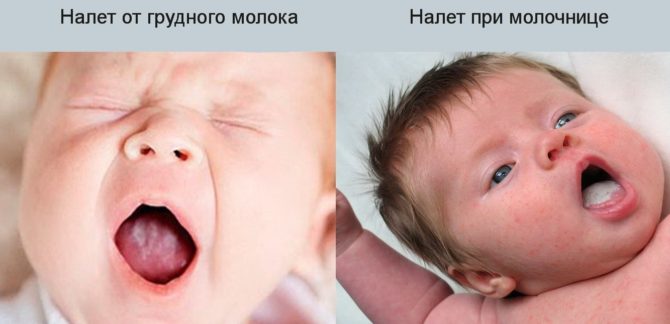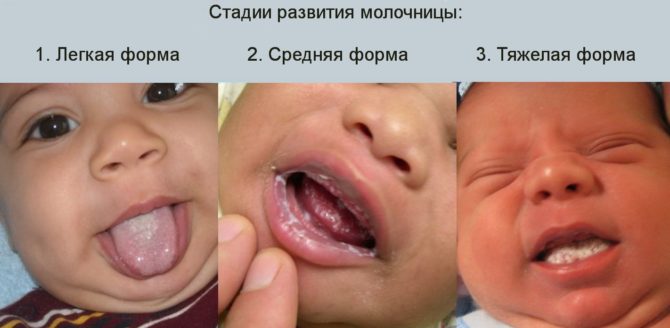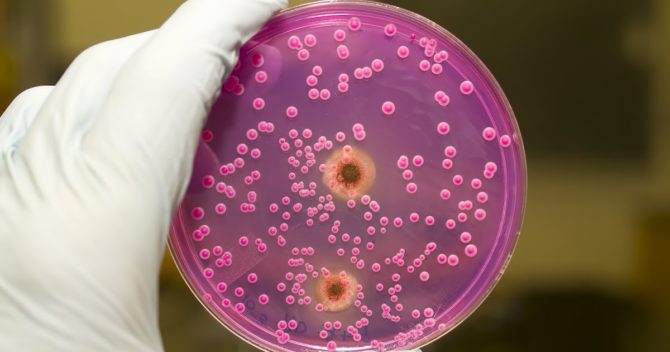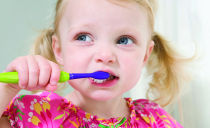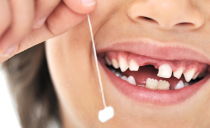Thrush in newborns, infants and infants on the tongue in the mouth
Fungal diseases of the oral mucosa are often detected in children. The detection in the mouth of a newborn or infant of signs of thrush requires immediate treatment: the lack of therapeutic measures is fraught with a deterioration in the general condition of the baby, the development of serious complications.
Content
Candidiasis in newborns: general concepts
Thrush that appears on the tongue in newborns is a pathology caused by Candida yeast-like fungi. The genus of infectious agents includes more than 150 types of unicellular protozoa, but most often the development of the disease in question is provoked by Candida albicans fungi.
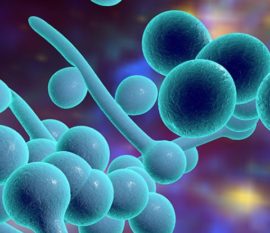 These microscopic organisms are human symbionts that acquire pathogenic properties only under certain conditions.
These microscopic organisms are human symbionts that acquire pathogenic properties only under certain conditions.
The main sign of a progressing illness is a white spot of a point-like nature that appears in the child's oral cavity. Inexperienced parents sometimes confuse discovered curdled formations with physiological deposits on the mucous membrane, since they look the same.
The natural plaque in the tongue that occurs after feeding (regurgitation) can be easily removed with a sterile gauze swab. Deposits signaling the development of the disease cannot be quickly removed. After elimination of pathological formations on the tissues of the oral cavity, redness, bleeding sores are detected.
The following photo will help to understand what physiological plaque and plaque with thrush in the mouth of a newborn baby looks like:
Thrush classification
Pediatricians distinguish 3 forms of the disease:
- Light, in which plaque is located on the cheeks, tongue. Deposits are point-islet in nature.
- Moderate, characterized by the appearance of plaque on hyperemic tissues of the hard palate, the lips of a child. Pathological formations diffusely cover the tongue and cheeks.
- Severe, characterized by the presence of membranous plaque, tightly soldered to the mucous membrane of the oral cavity. On examination, seizures, lesions of the skin, nails are revealed. The disease is accompanied by changes in the structure of the tissues of the bladder, bronchi, and internal organs of the child.
Get acquainted with the external manifestations of different forms of thrush, photo will help:
Infant thrush is divided into acute, which is quite easy to deal with, and chronic. The latter is characterized by the presence of relapses and differentiates into yeast glossitis, seizure, generalized forms of damage.
Danger of disease
According to statistics, at risk for candidiasis are infants born prematurely, infants with a weakened immune system and congenital malformations. Infants who have undergone surgical interventions, newborn babies who are breast-fed are susceptible to the development of the disease.
Thrush in the baby’s mouth progresses rapidly without treatment. The lack of necessary therapeutic measures leads to complications, including:
- malfunctioning of internal organs;
- weight loss (when abandoning breast milk);
- dehydration;
- candidal sepsis.
Refusal to visit a doctor, as well as treatment with folk remedies without prior consultation with a pediatrician, can lead to death.
Factors Stimulating the Development of the Disease
Active growth of colonies of saprophytic fungi occurs with a decrease in the immunity of the child. Lack of body resistance is caused by such reasons:
- malformations;
- birth injuries;
- malnutrition;
- the presence of infectious diseases.
Easy fixation of pathogens on the surface of the oral cavity of the infant contributes to the immaturity of the mucous membranes, tissue damage.
The child may become infected with candidiasis from the mother during passage through the birth canal, while breastfeeding. The source of infection can be relatives who were not treated for candidiasis in time, family members who violate the rules of hygiene.
Among the additional causes of the development of the disease:
- frequent spitting up;
- dry air, high temperature in the living room;
- excessive consumption of drinks containing sugar;
- poor-quality sterilization of bottles, nipple;
- non-compliance with sanitary standards.
Thrush in the mouth in infants and newborns can occur for reasons related to the characteristics of the treatment of certain diseases. In pediatrics, therapeutic regimens are often used, including corticosteroids and antibiotics. The latter cause dysbiosis in the child, upset the natural balance of intestinal microflora. In the absence of beneficial microorganisms, pathogens begin to actively develop.
Symptoms of thrush in the mouth in infants and children
Signs of candidiasis in babies vary depending on the stage of the disease, and may occur 5-10 days after birth.
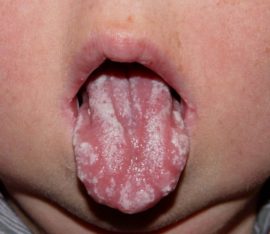 Symptoms of the first phase of the disease are disorders of the psycho-emotional state (tearfulness) and the appearance of plaque. It is difficult to remove pathological formations that look like small white dots. The child refuses to take breasts, is naughty.
Symptoms of the first phase of the disease are disorders of the psycho-emotional state (tearfulness) and the appearance of plaque. It is difficult to remove pathological formations that look like small white dots. The child refuses to take breasts, is naughty.
As thrush develops, deposits spread outside the mouth, localized in the throat. Plaque acquires a curdled consistency, becomes similar to dense white plaques, is not removed. It smells bad from the child’s mouth.
Thrush of the third stage in the baby is accompanied by the following symptoms:
- deposits cover the throat, lips, tonsils, palate, gums, cheeks;
- with palpation, enlarged lymph nodes are palpated;
- identified ulcers are characterized by increased bleeding.
The kid is worried, constantly crying, refuses food. Among the additional signs are elevated to 37.5 ° C temperature, lethargy, the presence of allergic reactions, a strong smell from the child's mouth. The disease spreads to the tissues of the gastrointestinal tract, manifests itself in the genital area. Plaque may acquire a yellow or brown tint.
The main diagnostic methods
At the first symptoms of the disease, you should consult a doctor to make a diagnosis and prescribe a treatment regimen for thrush in the mouth in infants. The initial determination of the presence of the disease occurs during a visual examination. Confirmation of the preliminary diagnosis is carried out on the basis of laboratory tests: the plaque separated from the mucosa is dried on a glass slide and processed using special preparations. The technique allows to determine the presence of fungus filaments.
The degree of resistance of infectious agents to antimycotic drugs is determined by invoking culture inoculation. The method is used for frequent relapses of candidiasis, low efficiency of classical treatment regimens prescribed for the relief of thrush in infants in the mouth.
It is necessary to carefully monitor the state of health of infants: with early detection of the disease, it is easier to determine the list of medications that need to be used.
Treatment of thrush in newborn babies, infants and children of different ages
Therapy of the disease is carried out taking into account the individual condition, the age of the small patient, the presence of allergic reactions to the components of the medicine, the form of the disease. The duration of treatment is determined by the doctor. The relief of the disease is carried out mainly at home.
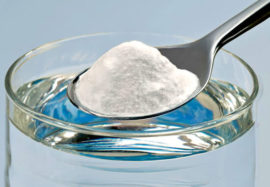 Thrush that appears in the mouth of newborns is recommended to be treated topically, without the involvement of antifungal drugs. Among the most effective means are soda, hydrogen peroxide (1%), a weak solution of potassium permanganate, alternative methods. Soda solution can be made at home. It is prepared as follows: a teaspoon of soda (sodium bicarbonate) is thoroughly mixed in half a glass of pre-boiled water.
Thrush that appears in the mouth of newborns is recommended to be treated topically, without the involvement of antifungal drugs. Among the most effective means are soda, hydrogen peroxide (1%), a weak solution of potassium permanganate, alternative methods. Soda solution can be made at home. It is prepared as follows: a teaspoon of soda (sodium bicarbonate) is thoroughly mixed in half a glass of pre-boiled water.
Medications until the child reaches the age of 6 months are used only after consulting a doctor.
It is permissible to treat thrush localized in the mouth of a six-month-old baby with the use of antifungal drugs: Nystatin, Miramistin, Vinilin, Candida. In some cases, Fluconazole tablets, Diflucan capsules (dosage is determined by the doctor), a solution of Nystatin with Cyanocobalamin are used.
How to treat thrush in the mouth of a baby
The procedure is very simple. It consists of 3 steps:
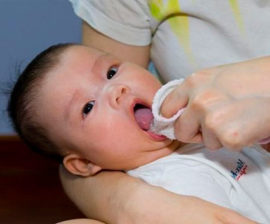 Cleaning the mouth with boiled water, cooled to room temperature.
Cleaning the mouth with boiled water, cooled to room temperature.- Treatment of the oral cavity with the above solutions. To carry out manipulations, a piece of sterile gauze (bandage) is fixed around the finger, the surface of the tissue is moistened with an antiseptic (soda, other solutions). The procedure begins with the mucous membrane of the cheeks, then the gums and the tongue of the child are processed. Lips are cleaned last. Remove plaque with neat movements. The frequency of medical manipulations is 3–6 times a day.
- Spot lubrication of affected surfaces with antimycotic drugs (do every 8-12 hours).
Similar manipulations, with the exception of the third paragraph, are also carried out to stop the ailment in newborn children. It is important to remember: the last stage of the considered algorithm is included only in treatment regimens for infants from 6 months.
In order to avoid repeated problems, after curing the baby, it is necessary to eliminate all factors that provoke the development of the disease.
The nuances of treatment
Using the mentioned funds from thrush in the mouth in newborns, a nursing mother should:
- pay attention to your own health;
- adjust your daily diet;
- ensure the creation of an optimal microclimate in the children's room;
- treat breasts with soda solution before each feeding;
- after feeding, give the baby several sips of clean water;
- boil bottles, nipples in a solution of baking soda.
You can cure a baby only with careful observance of all the recommendations of a pediatrician.
Folk remedies for thrush in children in the mouth
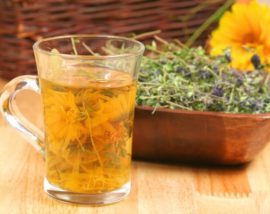 When deciding how to treat thrush that occurs in infants in the mouth, one should not forget about recipes for alternative medicine. Therapy may include decoctions of herbs: a mixture of equal parts of raw materials of chamomile, calendula, sage, yarrow, birch and poplar buds, eucalyptus leaves and juniper berries. The collection must be filled with 2 cups of boiling water, leave for 12 hours. When the composition is infused, it is used to treat the affected areas. It is recommended to do manipulations every 8 hours. A decoction can be given to a child instead of water.
When deciding how to treat thrush that occurs in infants in the mouth, one should not forget about recipes for alternative medicine. Therapy may include decoctions of herbs: a mixture of equal parts of raw materials of chamomile, calendula, sage, yarrow, birch and poplar buds, eucalyptus leaves and juniper berries. The collection must be filled with 2 cups of boiling water, leave for 12 hours. When the composition is infused, it is used to treat the affected areas. It is recommended to do manipulations every 8 hours. A decoction can be given to a child instead of water.
A good remedy for thrush, located in the mouth of infants, is a solution of honey. The liquid obtained by diluting 10 g of beekeeping product in 2 tbsp. l water, applied to affected areas. It should be remembered that treatment with honey often causes allergic reactions, therefore, before starting therapy, it is recommended to check with your doctor if you can use the drug to stop the manifestations of the disease in a child.
You can get rid of the disease by irrigation of the oral cavity with a decoction of St. John's wort: pour 60 g of leaves with water, boil, let it brew.The course of treatment can last up to 3 weeks.
Disease prevention
To get rid of candidiasis completely, it is necessary to adhere to a number of simple preventive measures. Among them:
- compliance with basic hygiene rules: wash your hands thoroughly, take care of the skin, mucous membranes of the child;
- maintaining an optimal microclimate in the apartment;
- strengthening the immunity of the child.
Thrush in a baby is a serious disease, the relapse of which can be avoided only with the help of a timely visit to a doctor. It is forbidden to independently treat childhood candidiasis without undergoing the necessary examinations, based on the knowledge obtained from newspaper (journal) articles.


